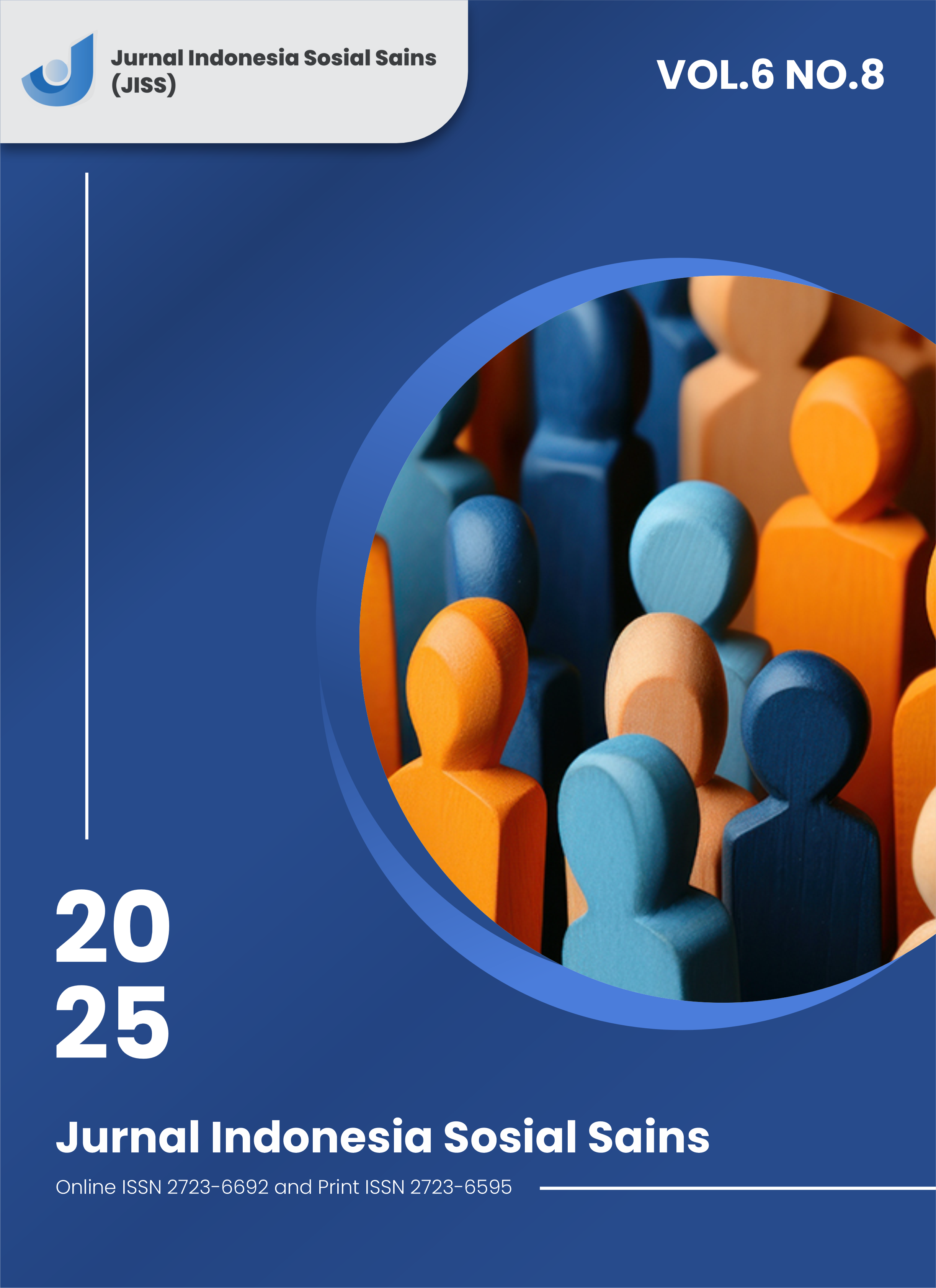Non-Metallic Mineral and Rock Mining Policy Within Metallic Mineral Concession Areas: Analysis and Strategic Recommendations
DOI:
https://doi.org/10.59141/jiss.v6i8.1830Keywords:
peridotite, limestone, nickel, laterite, rock, MBLBAbstract
Indonesia's position as the world's largest nickel producer, holding 42% of global reserves, has intensified mining activities across Sulawesi. However, recent findings by the Audit Board (BPK) in 2024 revealed systemic exploitation of regulatory loopholes, where non-metallic mineral permits (IUP) for rocks like peridotite and limestone are being misused to extract high-value nickel in Central and Southeast Sulawesi. This practice stems from three critical factors: (1) significantly easier permitting processes for rock commodities (14-day approval) versus metallic minerals (22-day auction system), (2) inadequate verification mechanisms for mineral content in rock concessions, and (3) weak coordination between central and regional oversight bodies. This study examines the multidimensional impacts of such permit misuse through qualitative policy analysis, incorporating geological assessments of nickel-bearing rock formations, comparative evaluation of licensing procedures, and economic modeling of state revenue losses. Findings demonstrate that 5%-10% unauthorized nickel extraction under rock permits could incur state losses of IDR 22.8-45.5 trillion annually, while simultaneously causing environmental degradation and undermining legitimate mining operations. The research proposes tiered policy interventions including real-time monitoring through the MOMI/MODI systems, mandatory nickel content verification for rock permits, and revised commodity classification frameworks. These recommendations aim to reconcile Indonesia's mineral governance with its dual objectives of resource nationalism and sustainable development, particularly crucial as the nation advances its nickel down streaming agenda.
References
Agustina, P. P., Herdiansyah, H., & Harahap, A. A. (2021). Illegal artisanal and small-scale mining practices: re-thinking approaches in Indonesia. 2nd International Conference Earth Science and Energy. Taylor & Francis Group.
Azhim, M.F., Widiastrawan, I. M. D., Soraya, N., Dewi, T. S., Semedie, T., & Pomalaa Nickel Exploration Team of PT Antam Geomin Unit. (2022). Geochemical and Physical Characteristics of Nickel-Cobalt Laterite Deposits on Maniang Island, Kolaka, Southeast Sulawesi, South Sulawesi: PIT IAGI 51st.
Camba, A. A. (2021). The unintended consequences of national regulations: Large-scale-small-scale relations in Philippine and Indonesian nickel mining. Resources Policy, 73, 102257. https://doi.org/10.1016/j.resourpol.2021.102257
Climate Rights International. (2024). Nickel unearthed: The human and climate costs of Indonesia's nickel industry. CRI Reports. https://cri.org/reports/nickel-unearthed/
CREA & CELIOS. (2024). Debunking The Value-Added Myth in Nickel Downstream Industry: Economic & Health Impact of Nickel Industry in Central Sulawesi, South East Sulawesi, and North Maluku.
Financial Audit Agency. (2024). Audit Report (LHP) for 2024 on the management of mineral, coal, and rock mining licenses from 2009 to 2009. Third Quarter 2023, Jakarta.
Kadir, A., Suaib, & Zuada. (2020). Mining in Southeast Sulawesi and Central Sulawesi: Shadow economy and environmental damage in regional autonomy era in Indonesia. Advances in Social Science, Education and Humanities Research, 431, 15-25.
Mighty Earth. (2024). From forests to electric vehicles: The deadly impact of nickel mining on Indonesia's last nomadic sea tribe. Mighty Earth Reports. https://mightyearth.org/article/from-forests-to-electric-vehicles/
Ministry of Energy and Mineral Resources. (2025). Legal Information Network and Documentation. Retrieved 20-06-2025, from: https://jdih.esdm.go.id/dokumen/view?id=2396.
Ministry of Energy and Mineral Resources. (2025). Mineral and Coal Information Data. Retrieved 2025-06-28, from: https://geoportal.esdm.go.id/minerba/.
Minerba. (2021). Grand Strategy of Minerals and Coal: Direction of Upstream and Downstream Development of Main Minerals and Coal Towards Advanced Indonesia, Jakarta.
Mongabay Indonesia. (2023). Nickel Mining and the Threat of Environmental Damage in Sulawesi. Retrieved from: https://mongabay.co.id/2024/01/08/catahu-walhi-sulsel-2023-soroti-krisis-iklim-transisi-energi-dan-hilirisasi-nikel/.
Octavianti, T., & Staddon, C. (2021). A review of 70 years of complexity and evolution in Indonesian water policy and the regulatory framework. Water Policy, 23(1), 1-18.
Rahmat, A. I., Sari, D. K., & Putri, N. S. (2024). Illegal mining in Indonesia: need for robust legislation and enforcement. Cogent Social Sciences, 10(1), 2358158. https://doi.org/10.1080/23311886.2024.2358158
Rohman, A., Hartiwiningsih, H., & Rustamaji, M. (2024). Improving ecological justice orientation through a typological approach to illegal mining in the criminal justice system. Cogent Social Sciences, 10(1), 2299083. https://doi.org/10.1080/23311886.2023.2299083
Schulte, I., & Knoblauch, D. (2022). Nationalist enclaves: Industrialising the critical mineral boom in Indonesia. The Extractive Industries and Society, 12, 101221. https://doi.org/10.1016/j.exis.2024.101606
Shanghai Metal Market. (2025). Latest Update in the SMM Nickel Market, retrieved 2025-05-28, from: https://www.metal.com/Nickel.
Spiegel, S. J. (2015). Governance institutions, resource rights regimes, and the informal mining sector: Regulatory complexities in Indonesia. World Development, 40(1), 189-205. https://doi.org/10.1016/j.worlddev.2011.05.015
Widiatedja, I. G. N. P. (2024). Indonesia's rational choice in the nickel ore export ban policy. Cogent Social Sciences, 10(1), 2400222. https://doi.org/10.1080/23311886.2024.2400222
Yanto, A., & Rahayu, P. (2024). Countering illegal tin mining with a legal formulation of law based on local wisdom in Bangka Belitung, Indonesia. Cogent Social Sciences, 10(1), 2311053. https://doi.org/10.1080/23311886.2024.2311053
Downloads
Published
How to Cite
Issue
Section
License
Copyright (c) 2025 Jumbadi

This work is licensed under a Creative Commons Attribution-ShareAlike 4.0 International License.
Authors who publish with this journal agree to the following terms:
- Authors retain copyright and grant the journal right of first publication with the work simultaneously licensed under a Creative Commons Attribution-ShareAlike 4.0 International. that allows others to share the work with an acknowledgement of the work's authorship and initial publication in this journal.
- Authors are able to enter into separate, additional contractual arrangements for the non-exclusive distribution of the journal's published version of the work (e.g., post it to an institutional repository or publish it in a book), with an acknowledgement of its initial publication in this journal.
- Authors are permitted and encouraged to post their work online (e.g., in institutional repositories or on their website) prior to and during the submission process, as it can lead to productive exchanges, as well as earlier and greater citation of published work.












